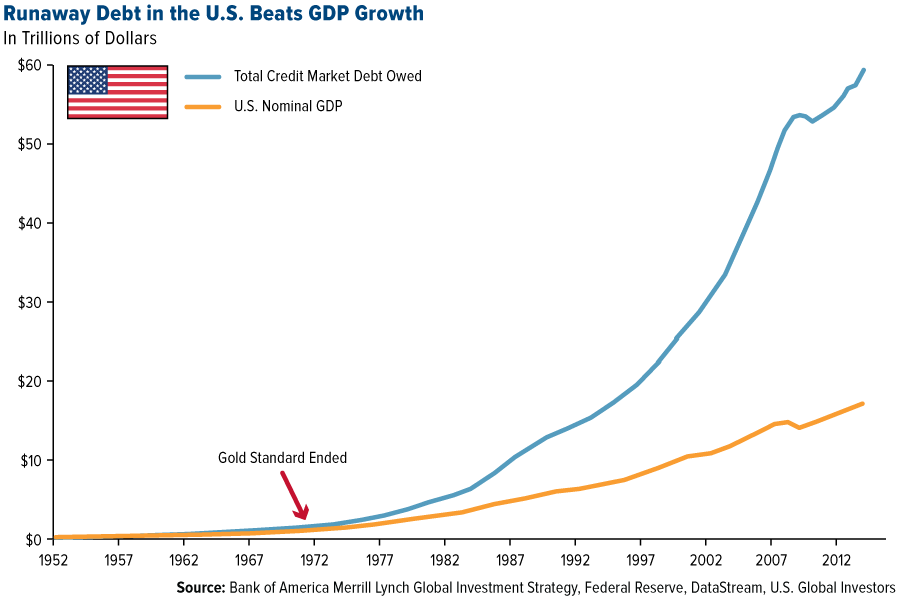Gold Standard Myths; It’s All About Power
If you want to be ridiculed by mainstream pundits, economists, and financial analysts, just bring up the gold standard.

Republican presidential candidate Ted Cruz got the full treatment after a recent GOP debate when he had the audacity to suggest, “I think the Fed should get out of the business of trying to juice our economy, and simply be focused on sound money and monetary stability, ideally tied to gold.”
Cruz’s passing references to the gold standard led to howls of protest. Based on the hue and cry, you’d think the Texas senator had suggested the earth was flat.
According to the mainstream, nothing is more certain than the fact that the gold standard is a relic that should be forever relegated to the dustbin of history. But like a lot of conventional wisdom, the anti-gold rhetoric isn’t so wise. In fact, much of it is based on pure myth.
The primary purpose of the gold standard is to tie money to something tangible and stable. As it stands today, currency simply floats around like an untethered balloon. Central planners love this because it empowers them to just blow it in any direction they please. But as Steve Forbes points out in a recent column, the concept of untethered money is really absurd:
The purpose of a gold standard is to ensure that a currency has a fixed value, just as measures of time, weight and distance are fixed. We don’t ‘float’ the number of minutes in an hour or inches in a foot. Yet, strangely, economists believe that constantly changing the value of a currency is good for growth.”
In truth, it’s good for politicians, central planners and government power brokers.
When the money supply is tied to something tangible and relatively fixed like gold, it naturally limits the amount the government can circulate. When it is “free-floating,” the government can print as much as it wants. Politicians love this, of course. More money means more spending. More spending means more opportunities to essentially buy votes. And of course, all of this means more debt, as Frank Holmes recently pointed out:
When money is limited, as it is in a true gold standard system, so too is reckless government spending. You can see how dramatically all debt in the US, both public and private, began to soar past economic growth once the gold standard was ended.”

So, the political class has a vested interest in maintaining a system based on fiat currency. It isn’t about economics; it’s about power.
But they have to sell it somehow, so they rely on mythmaking to besmirch and tarnish the gold standard. Here are just three of the many myths.
1. Gold restrains economic growth.
This is simply untrue, as Forbes points out:
It does the opposite. When the value of a currency is stable, investment flourishes–and so does economic activity. For instance, from about two years after WWII to when we cut the dollar’s link to the yellow metal in 1971, the average annual growth in our industrial output was an astonishing 5%. After that it slumped to less than half that amount.”
A stable monetary system does the exact opposite. It creates the foundation for economic growth.
2. The gold standard leads to economic instability.
History once again proves this a myth. The US went on a classic gold standard in 1879. As Holmes points out, the ensuing period up until WWI was one of the least volatile in American history:
Between 1879 and 1913, when the classic gold standard is in effect, the US actually experiences an average deflationary rate of negative 0.02%. At the same time, consumer prices have a standard deviation of only 1.98. Inflation never falls below negative 4.74%or rises above 4.53%. The other periods, by contrast, have huge swings in consumer prices.”
3. Gold artificially restricts the money supply, hurting the economy.
Tying money to gold merely sets a stable value. The limits really only constrain politicians and central planners, not the economy. Again, Forbes smashes this myth.
The amount of gold doesn’t restrict the money supply any more than the supply of rulers would restrict the size of a house you might construct. It merely ensures that money has a fixed, stable value. As Nathan Lewis has pointed out, from 1775 to 1900 the U.S. grew from a small agricultural economy of 2.5 million people to the world’s mightiest industrial nation of 76 million people. During most of that time the dollar was fixed to gold. The global output of gold went up 3.4-fold, yet the U.S.’ money supply burgeoned 163-fold.”
As you can see, these myths are easily dispelled with a look at economic history. But again, it’s not about economics. Politicians and central planners love the power fiat currency offers them. Ben Carson illustrated the political class’ devotion to central planning after the GOP debate, expressing his unwillingness to upset the Federal Reserve status quo.
Forbes summed it up perfectly:
The New York Times and many economists like the idea of government dominating the economy; honest money advocates don’t.”
Get Peter Schiff’s most important Gold headlines once per week – click here – for a free subscription to his exclusive weekly email updates.
Interested in learning more about physical gold and silver?
Call 1-888-GOLD-160 and speak with a Precious Metals Specialist today!




 Since Nayib Bukele became president of El Salvador, El Salvador has been in American media and global political discussion more than ever. While much of the attention focuses on Bukele’s mass incarceration of gang members and a decline in homicide of over 70%, Bukele has also drawn attention to his favoritism towards Bitcoin and how he […]
Since Nayib Bukele became president of El Salvador, El Salvador has been in American media and global political discussion more than ever. While much of the attention focuses on Bukele’s mass incarceration of gang members and a decline in homicide of over 70%, Bukele has also drawn attention to his favoritism towards Bitcoin and how he […] With gold hitting yet another awe-inspiring all-time high in the wake of Powell’s remarks reassuring markets (more or less) to expect rate cuts in 2024, a few analysts are pointing out risk factors for a correction — so is there really still room to run?
With gold hitting yet another awe-inspiring all-time high in the wake of Powell’s remarks reassuring markets (more or less) to expect rate cuts in 2024, a few analysts are pointing out risk factors for a correction — so is there really still room to run? Gold hit a new all-time nominal high, surpassing the previous record set in December of the previous year. The precious metal’s price reached approximately $2,140, indicating a robust and continuing interest in gold as a safe-haven asset, despite a rather peculiar lack of fanfare from the media and retail investors. This latest peak in gold […]
Gold hit a new all-time nominal high, surpassing the previous record set in December of the previous year. The precious metal’s price reached approximately $2,140, indicating a robust and continuing interest in gold as a safe-haven asset, despite a rather peculiar lack of fanfare from the media and retail investors. This latest peak in gold […] The gold price has been surging, with unprecedented central bank demand gobbling up supply. It has been a force to behold — especially as US monetary policy has been relatively tight since 2022, and 10-year Treasury yields have rocketed up, which generally puts firm downward pressure on gold against USD.
The gold price has been surging, with unprecedented central bank demand gobbling up supply. It has been a force to behold — especially as US monetary policy has been relatively tight since 2022, and 10-year Treasury yields have rocketed up, which generally puts firm downward pressure on gold against USD.  Total gold demand hit an all-time high in 2023, according to a recent report released by the World Gold Council. Last week, the World Gold Council (WGC) released its Gold Demand Trends report, which tracks developments in the demand for and use of gold around the world. Excluding over-the-counter (OTC) trade, 2023 gold demand fell slightly from 2022 […]
Total gold demand hit an all-time high in 2023, according to a recent report released by the World Gold Council. Last week, the World Gold Council (WGC) released its Gold Demand Trends report, which tracks developments in the demand for and use of gold around the world. Excluding over-the-counter (OTC) trade, 2023 gold demand fell slightly from 2022 […]
This is one big Reason Dr. Ben Carson lost my support!!
Thanks for all your great info. What might have happened if Nixon hadn’t taken the US off gold?